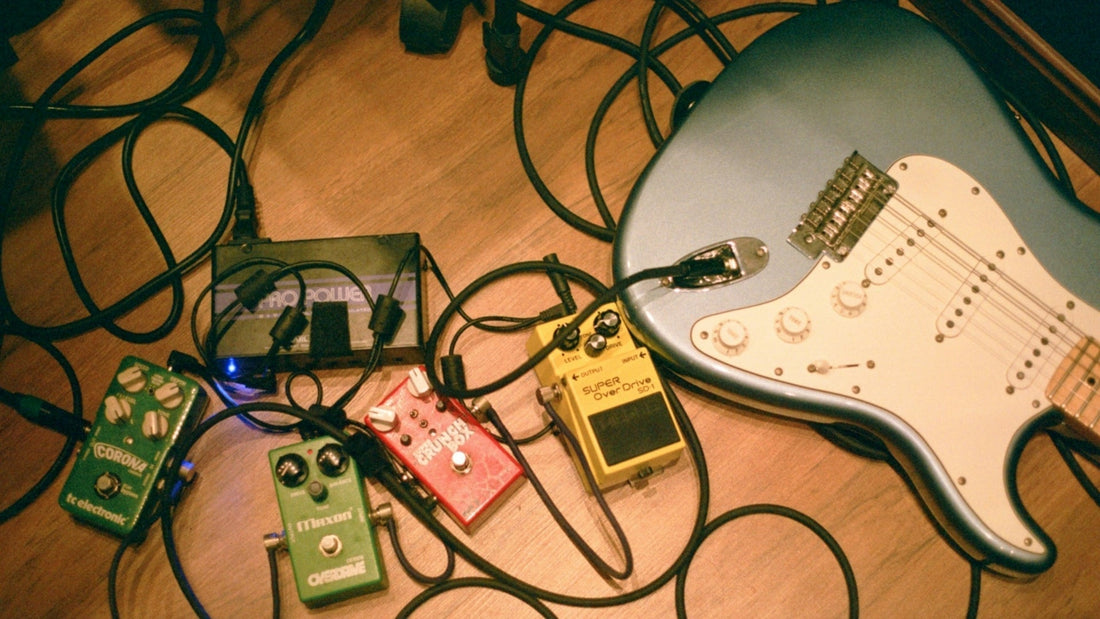Analog vs. Digital Guitar Pedals: Understanding the Key Differences
The debate between analog and digital guitar pedals has been going on for decades, and for good reason. Both types offer unique ways to shape your sound and express your style. Analog pedals have a warm, organic tone and a natural response, while digital pedals provide unmatched flexibility and precision.
Modern technology has blurred the line between the two, making it harder than ever to choose. Whether you are chasing vintage grit or futuristic tones, understanding how each type works will help you make better gear decisions.
In this guide, we'll break down what makes analog and digital pedals different, their pros and cons, and which one might be the right fit for your pedalboard.

What Are Analog Guitar Pedals? (And Why Guitarists Love Them)
Analog guitar pedals use traditional electronic components like transistors, resistors, and capacitors to shape your guitar's sound in real time. Instead of converting your signal into digital data, they process it as a continuous electrical waveform, preserving every nuance of your playing.
This is what gives analog pedals their signature warmth, natural compression, and organic feel that many guitarists love.
Because of their simplicity, analog pedals often respond more dynamically to picking intensity and guitar volume, making them highly expressive and musical. They're also easy to tweak, with straightforward knobs that encourage experimentation.
For players who value raw tone and touch sensitivity, analog pedals remain the gold standard for creating authentic, character-filled sounds.
Best Analog Pedals Examples
BMF Effects El Jefe Overdrive
The BMF Effects El Jefe Overdrive is a dynamic, touch-sensitive pedal that rules the low to medium gain range with authority. Designed for players who crave rich, responsive tone, it delivers smooth crunch and natural breakup that cleans up beautifully with your guitar’s volume knob. For players who crave that analog touch, this pedal delivers it all with classic character.
Flattley Nirvana Analogue Delay
The Flattley Nirvana Analogue Delay delivers rich, vintage-style echoes with the lush warmth only true analog circuitry can provide. Using classic bucket brigade chips, it recreates the smooth, natural decay of iconic delay tones from the past, perfect for adding depth, atmosphere, or rhythmic repeats to your sound.
Warm Audio WA-C1 Chorus Vibrato
The Warm Audio WA-C1 Chorus Vibrato is a faithful recreation of one of the most iconic modulation pedals ever made, now enhanced with modern flexibility and premium components. Powered by the legendary MN3007 Xvive BBD chip, it delivers the lush, dimensional tones that defined the sounds of artists like Queen and the Red Hot Chili Peppers.
What Are Digital Guitar Pedals? (How DSP Changed the Game)
Digital guitar pedals use digital signal processing (DSP) to shape your sound with incredible precision and flexibility. Instead of processing your guitar signal as a continuous analog waveform, these pedals convert it into digital data, allowing complex algorithms to manipulate tone, delay, modulation, and more.
This technology enables effects that would be impossible or impractical in analog form, such as shimmering reverbs, multi-tap delays, and realistic amp modeling.
Modern digital pedals are capable of studio-quality sound with pristine clarity and consistency. Many also include presets, MIDI control, and deep customization options, making them ideal for live performers and studio musicians alike. Popular examples include the Line 6 HX One and the Strymon BigSky MX, all known for their versatility and professional-grade sound.
In short, digital pedals revolutionized the effects world by combining high-fidelity tone with limitless creative possibilities.
Best Digital Pedals Examples
Strymon BigSky MX
The Strymon BigSky MX redefines what a reverb pedal can do, combining immense processing power with breathtaking sonic realism. Equipped with 12 world-class reverb engines, including seven all-new algorithms, the BigSky MX delivers everything from lush ambient textures to pristine studio reverbs with unmatched depth and character.
Line 6 HX One
DigiTech Whammy
The DigiTech Whammy is a true legend in pitch-shifting and digital harmony effects, delivering the iconic sounds that have defined countless recordings and live performances. Known for its expressive pitch bends, dive bombs, and harmony shifts, the Whammy gives guitarists access to everything from subtle octave layering to wild, soaring pitch sweeps.
Key Differences Between Analog and Digital Pedals
When comparing analog and digital guitar pedals, the main differences come down to tone, response, flexibility, and reliability. Each type has its own strengths depending on what kind of player you are and the sounds you’re after.
- Tone: Analog pedals produce a warm, natural character that feels organic and musical, while digital pedals are known for their clarity and ability to replicate complex effects with precision.
- Response: Analog circuits react directly to your playing dynamics, offering a more touch-sensitive feel. Digital pedals, on the other hand, deliver consistent performance no matter how hard you play.
- Flexibility: Analog pedals usually focus on one specific effect and have simple controls. Digital pedals can store multiple presets and combine several effects in one unit.
- Reliability and maintenance: Analog pedals are easier to repair but can drift in performance over time, while digital pedals require less maintenance but depend on software stability.

Analog vs. Digital Pedals: Pros and Cons
|
Type |
Pros |
Cons |
|
Analog Pedals |
|
|
|
Digital Pedals |
|
|
Analog vs. Digital: Which Guitar Pedals Are Right for You?
Choosing between analog and digital pedals depends on your tone goals, playing style, and setup. If you love raw, expressive sounds and prefer hands-on control, analog pedals are often the way to go. They excel at capturing your touch and delivering that classic, musical warmth that reacts naturally to your playing.
If you need flexibility, consistency, and a wide range of sounds in a compact rig, digital pedals might be your best choice. They're perfect for players who switch between genres, perform live with presets, or want to explore complex ambient or modulated tones.
Many modern guitarists use a mix of both, combining the organic feel of analog drives with the precision of digital reverbs and delays. Try both worlds and build a pedalboard that reflects your sound and style.
Frequently Asked Questions
Can Digital Pedals Sound Like Analog Pedals?
Modern digital pedals can closely emulate analog circuits thanks to advanced DSP technology, though some players still prefer the organic feel of true analog circuitry.
Should I Mix Analog and Digital Pedals on My Board?
Absolutely. Many guitarists combine both to enjoy the best of both worlds: analog warmth with digital flexibility and convenience.
Which Is More Reliable: Analog or Digital Pedals?
Analog pedals are simple and easy to repair, while digital pedals can be more complex but generally offer consistent performance and features like presets and MIDI control.

Conclusion
Both analog and digital guitar pedals have their own magic, and the best choice depends on what inspires you most. Analog pedals bring warmth, character, and a direct connection between your hands and your tone, while digital pedals open the door to limitless versatility, precision, and convenience.
Many modern players use a mix of both, blending analog overdrives and fuzzes with digital reverbs, delays, and modulation effects for the perfect balance. Whether you're chasing vintage grit or crafting expansive soundscapes, understanding the strengths of each type will help you build a pedalboard that truly reflects your sound.
More Interesting Reads:
Best Guitar Pedals on a Budget | $150 & Under
Pedal Stacking 101: Combining Effects for Unique Sounds
Essential Guitar Pedals for Beginners | What Pedals Should I Buy First?
Bonus: Use the code IASN10 at checkout for an extra 10% discount!*
*Exclusions apply. Contact sales@deathcloud.com for more information.







